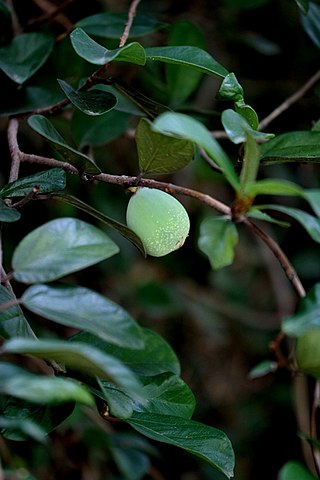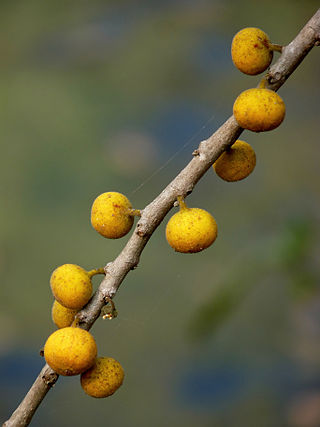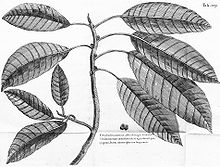
Ficus is a genus of about 850 species of woody trees, shrubs, vines, epiphytes and hemiepiphytes in the family Moraceae. Collectively known as fig trees or figs, they are native throughout the tropics with a few species extending into the semi-warm temperate zone. The common fig (F. carica) is a temperate species native to southwest Asia and the Mediterranean region, which has been widely cultivated from ancient times for its fruit, also referred to as figs. The fruit of most other species are also edible though they are usually of only local economic importance or eaten as bushfood. However, they are extremely important food resources for wildlife. Figs are also of considerable cultural importance throughout the tropics, both as objects of worship and for their many practical uses.

Ficus macrophylla, commonly known as the Moreton Bay fig or Australian banyan, is a large evergreen banyan tree of the Mulberry Family (Moraceae) native to eastern Australia, from the Wide Bay–Burnett region in the north to the Illawarra in New South Wales, as well as Lord Howe Island where the subspecies F. m. columnaris is a banyan form covering 2.5 acres or more of ground. Its common name is derived from Moreton Bay in Queensland, Australia. It is best known for its imposing buttress roots.

Ficus rubiginosa, the rusty fig or Port Jackson fig, is a species of flowering plant native to eastern Australia in the genus Ficus. Beginning as a seedling that grows on other plants (hemiepiphyte) or rocks (lithophyte), F. rubiginosa matures into a tree 30 m (100 ft) high and nearly as wide with a yellow-brown buttressed trunk. The leaves are oval and glossy green and measure from 4 to 19.3 cm long and 1.25 to 13.2 cm wide.

Ficus citrifolia, also known as the shortleaf fig, giant bearded fig, Jagüey, wild banyantree and Wimba tree, is a species of banyan native to southern Florida, the Caribbean, Mexico, Central America, and northern South America south to Paraguay. It is distinguished from the closely related Florida strangler fig mainly by the finer veining in the leaves.

Syconium is the type of fruit borne by figs, formed by an enlarged, fleshy, hollow receptacle with multiple ovaries on the inside surface. In essence, it is really a fleshy stem with a number of flowers, so it is considered both a multiple and accessory fruit.

Ficus pumila var. awkeotsang, also known as the jelly fig, aiyu, or ai-yu, is a variety of Ficus pumila, and a member of the fig family Moraceae, native to Taiwan. The plant is known for its use in making aiyu jelly.
Ficus crassiuscula is a species of flowering plant in the family Moraceae, native to Central America and north-western parts of South America.

Ficus aurea, commonly known as the Florida strangler fig, golden fig, or higuerón, is a tree in the family Moraceae that is native to the U.S. state of Florida, the northern and western Caribbean, southern Mexico and Central America south to Panama. The specific epithet aurea was applied by English botanist Thomas Nuttall who described the species in 1846.

Ficus insipida is a common tropical tree in the fig genus of the family Moraceae growing in forest habitats along rivers. It ranges from Mexico to northern South America.

Ficus americana, commonly known as the West Indian laurel fig or Jamaican cherry fig, is a tree in the family Moraceae which is native to the Caribbean, Mexico in the north, through Central and South America south to southern Brazil. It is an introduced species in Florida, USA. The species is variable; the five recognised subspecies were previously placed in a large number of other species.

Ficus pleurocarpa, commonly known as the banana fig, karpe fig or gabi fig, is a fig that is endemic to the wet tropical rainforests of northeastern Queensland, Australia. It has characteristic ribbed orange and red cylindrical syconia. It begins life as a hemiepiphyte, later becoming a tree up to 25 m (82 ft) tall. F. pleurocarpa is one of the few figs known to be pollinated by more than one species of fig wasp.

Ficus obliqua, commonly known as the small-leaved fig, is a tree in the family Moraceae, native to eastern Australia, New Guinea, eastern Indonesia to Sulawesi and islands in the southwestern Pacific Ocean. Previously known for many years as Ficus eugenioides, it is a banyan of the genus Ficus, which contains around 750 species worldwide in warm climates, including the edible fig. Beginning life as a seedling, which grows on other plants (epiphyte) or on rocks (lithophyte), F. obliqua can grow to 60 m (200 ft) high and nearly as wide with a pale grey buttressed trunk, and glossy green leaves.
Ficus yoponensis is a species of fig tree found in Central and South America. It can grow to heights of 40–50 metres (130–160 ft) tall, having a trunk diameter of 1 metre (3.3 ft). The trunk is buttressed, light grey in colour and reasonably smooth. Its petioles are 1–2.5 centimetres (0.39–0.98 in) long, the stipules are straight and 3–5 centimetres (1.2–2.0 in) long. The leaves and stems are hairless. The leaves are 6–11 centimetres (2.4–4.3 in) long and 2.5–4 centimetres (0.98–1.57 in) wide, but larger in juveniles, being up to 28 centimetres (11 in) long and 5 centimetres (2.0 in) wide. The time at which they flower varies between individuals, but each tree tends to flower at a similar time each year. As in all figs, the flowers are enclosed inside the fig and can only be accessed by fig wasps, which enter to pollinate the flowers and lay their own eggs. The resulting fruit grows to 1.8 centimetres (0.71 in) in diameter and turns from green to purple with maturity. On average in Panama, F. yoponensis produce a new flush of leaves every 20 weeks and flower every 25 weeks. The species is similar in appearance to Ficus insipida but has smaller leaves, stipules and fruits and only occurs in primary forest whereas F. insipida is also found in secondary forest.

Ficus variegata is a well distributed species of tropical fig tree. It occurs in many parts of Asia, islands of the Pacific and as far south east as Australia. There is a large variety of local common names including common red stem fig, green fruited fig and variegated fig. A non strangling fig which may reach 30 metres in height. The tree is evergreen when young but becomes briefly deciduous as it grows older. In Australia the fruit are eaten by cassowaries and double-eyed fig parrots.

Blastophaga psenes is a wasp species in the genus Blastophaga. It pollinates the common fig Ficus carica and the closely related Ficus palmata. Without a colony or nest, these wasps breed in figs and the adults live for only a few days or weeks. They locate the fig they wish to pollinate through olfactory senses.

Ceratosolen is an Old World wasp genus in the family Agaonidae. They are pollinators of the monoecious fig subsections Sycomorus and Sycocarpus, and the section Neomorphe, all belonging to the subgenus Sycomorus. The genus is native to the Palearctic, Afrotropical, Indomalayan and Australasian realms.

Ficus exasperata, also called the sandpaper tree, forest sandpaper fig, white fig, or sandpaper leaf tree, is a deciduous, and dioecious species of plant in the mulberry family Moraceae, native to tropical Africa and southern Asia.

The genus Ficus is composed of 800 species of vines, shrubs, and trees, defined by their syconiums, the fruit-like vessels that either hold female flowers or pollen on the inside. In addition to being cultivated by humans for thousands of years, Ficus is also known for their reproductive mutualism with the fig wasp.
Ficus amplissima, also known as the Indian bat tree, Indian bat fig, Pimpri, Pipri (Piparee), Pipali or Bilibasari mara is a tree species of flowering plants that belongs to Moraceae, the fig or mulberry family. It is native to Central and southern Peninsular India, Sri Lanka and Maldives, having a significant distribution throughout Western Ghats of India. It is most commonly planted to provide shade in coffee plantations due to its dense and wide foliage. The ripened figs attract many birds, especially during the spring.
Ficus bernaysii is a lowland rainforest tree in the family Moraceae, native to an area from New Guinea to the Solomon Islands. It is dioecious, and grows cauliflorous fruit. It is fed on by a wide range of animals.

















